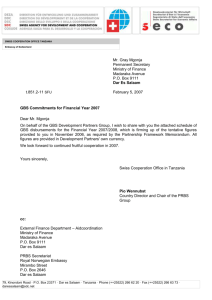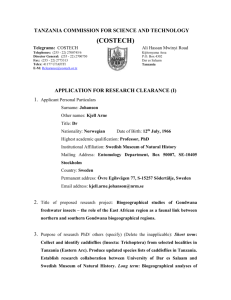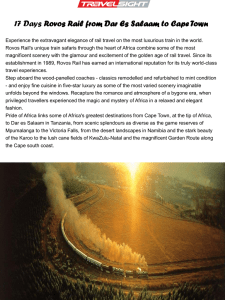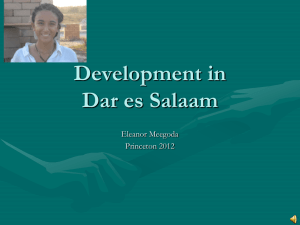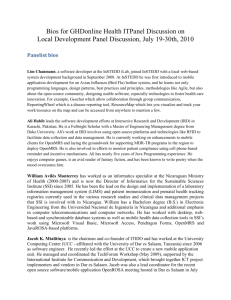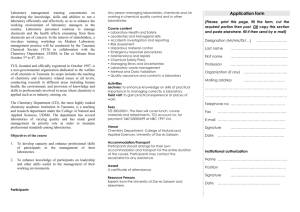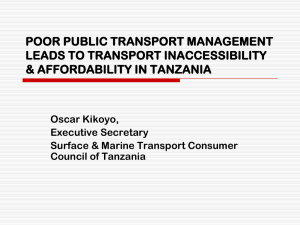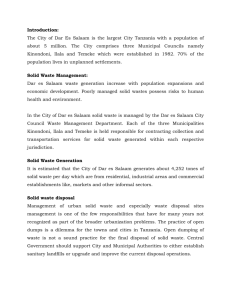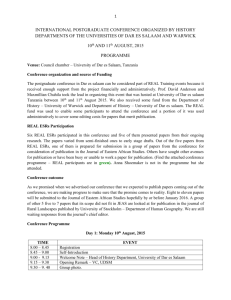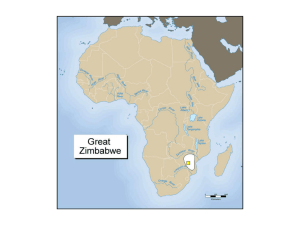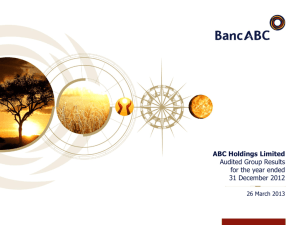SUN, SEPT 27, 2009 - the Duke Beta Website
advertisement
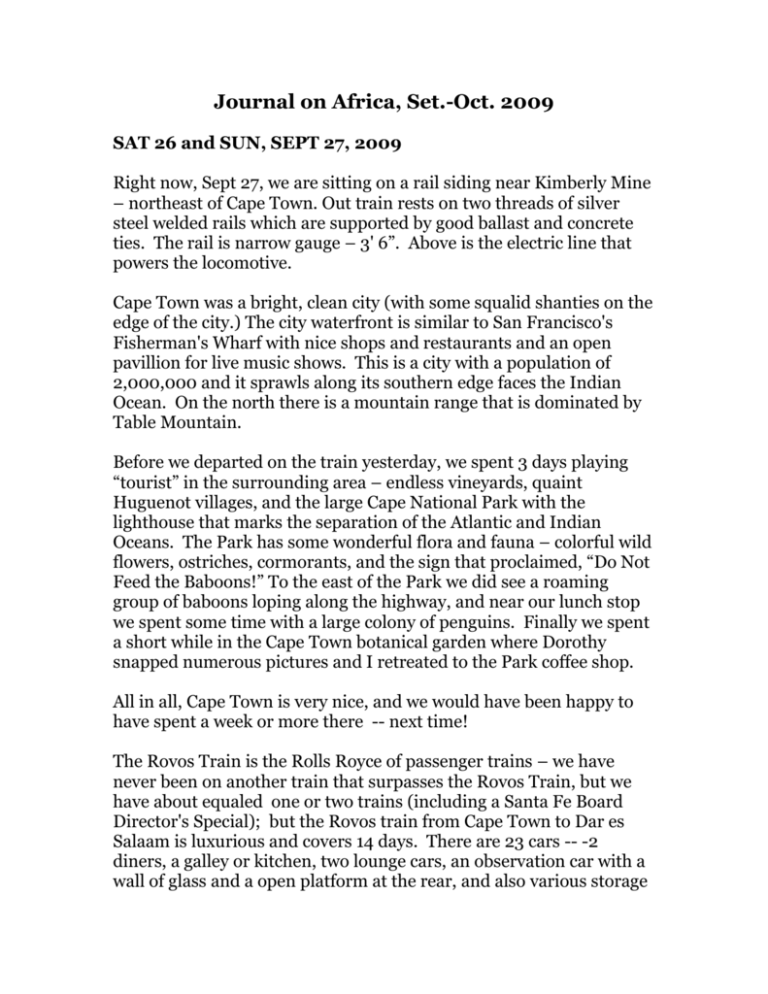
Journal on Africa, Set.-Oct. 2009 SAT 26 and SUN, SEPT 27, 2009 Right now, Sept 27, we are sitting on a rail siding near Kimberly Mine – northeast of Cape Town. Out train rests on two threads of silver steel welded rails which are supported by good ballast and concrete ties. The rail is narrow gauge – 3' 6”. Above is the electric line that powers the locomotive. Cape Town was a bright, clean city (with some squalid shanties on the edge of the city.) The city waterfront is similar to San Francisco's Fisherman's Wharf with nice shops and restaurants and an open pavillion for live music shows. This is a city with a population of 2,000,000 and it sprawls along its southern edge faces the Indian Ocean. On the north there is a mountain range that is dominated by Table Mountain. Before we departed on the train yesterday, we spent 3 days playing “tourist” in the surrounding area – endless vineyards, quaint Huguenot villages, and the large Cape National Park with the lighthouse that marks the separation of the Atlantic and Indian Oceans. The Park has some wonderful flora and fauna – colorful wild flowers, ostriches, cormorants, and the sign that proclaimed, “Do Not Feed the Baboons!” To the east of the Park we did see a roaming group of baboons loping along the highway, and near our lunch stop we spent some time with a large colony of penguins. Finally we spent a short while in the Cape Town botanical garden where Dorothy snapped numerous pictures and I retreated to the Park coffee shop. All in all, Cape Town is very nice, and we would have been happy to have spent a week or more there -- next time! The Rovos Train is the Rolls Royce of passenger trains – we have never been on another train that surpasses the Rovos Train, but we have about equaled one or two trains (including a Santa Fe Board Director's Special); but the Rovos train from Cape Town to Dar es Salaam is luxurious and covers 14 days. There are 23 cars -- -2 diners, a galley or kitchen, two lounge cars, an observation car with a wall of glass and a open platform at the rear, and also various storage cars. The interior passenger cars and common rooms are clad with mahogany and the compartments are relatively spacious. In our car, there were only three compartments. The train is well staffed with attractive young men and women, black and white. In addition to the room attendants, waiters, and bartenders, the train has a historian, a hairdresser and a doctor. The passengers (60) are from 8 countries – UK, USA, Germany, Holland, Denmark, Canada, Portugal and Russia. The 25 Germans outnumber the 14 Americans although English is used on the train and during the off-train activities. The median age is about 6o. Most of the passengers are traveling as couples but there are 7 single women and 3 single men on the train. Now we have arrived the Kimberly Mine – known as the “Big Hole.” The Kimberly Mine was in operation from 1871 to 1914. The top of the hole covered 42 acres and it reached a depth of 790 feet. It is estimated that 50,ooo miners dug the hole with shovels and picks during those 43 years. The Mine produced 6,000 pounds of diamonds. The Kimberly Mine started with many, many small claims extracting the diamonds; but with time, Cecil Rhodes purchased the small claims and eventually his company, DeBeers Consolidated Mines, created a monopoly for diamonds. After touring the Mine we got back on the train and headed north toward Pretoria. MON, SEPT 28 This morning we neared Johannesburg and we moved on to Pretoria. Later in the morning we arrived at the Rovos 60-acre yard where numerous passenger cars and steam and diesel locomotives were being rebuilt. We toured the rail yard and then had lunch at the Rovos headquarters. Later in the day our train will be powered by a steam locomotive. It will take us to the Madikwe Game Reserve where we will be for two nights. After lunch we took an extensive bus tour of Pretoria. Pretoria is an orderly, clean city with its capital buildings, broad parks, and monuments. The South Africa “White House” was designed by a famous English architect who was also designed the Indian Legislature in New Delhi. I believe it was Herbert Baker. ExPresident Mandela has a very nice home within a couple of blocks of the “White House”. Before we again aboarded the train, we stopped at the Voortrekker Monument, completed in 1949, with a commanding view over Pretoria. The monument honors the thousands of Boers who left the Cape area from 1835 to 1854 and trekked into the middle of South Africa. The Boers were unsatisfied with the British control over the Cape area and were seeking land which the Boers could own and govern. The Boers trekked into the middle of South Africa and established a government in the Transvaal and the Orange Free State. The Boers ruled over these lands until 1899. But from 1899 to 1902 the British fought with the Boers, and in 1902 Britain won the war and added this territory to South Africa. A section of the Voortrekker Monument “honors” the Boers who fought with the Zulus at Blood River in 1883. The Zulus had 15,000 warriors armed with spears and the 460 Boers were armed with rifles. On December 16, more than 3000 Zulus were slain and the remaining Zulus fled in complete disorder. The Boer casualties were 3 injured and none were killed. Later in the afternoon we again aboard the train and head toward the game lodge. I hope at the Lodge there will be a connection with the world and I will send this Email. TUES, SEPT 29 Last night we had bad rain storm –lightening and thunder. During the night the locomotive developed a problem and we arrived at the game preserve about 5 hours late. The Madikwe Game Preserve is about 20 miles south of the Botswana border. At sundown we made our first drive into the preserve and saw some elephants and various interesting birds and various types of antelopes. Maybe tomorrow there may be “Tigers (maybe in Oz but not in Africa since tigers come only from Asia) and Lions, oh my.” Dorothy!!! Supposedly we can send an Email tomorrow, so I will cut this short. WED, SEPT 30, 2009 Our attempts to connect with the net at the game lodge failed, so we will try again tomorrow in Victoria Falls. Most of group was sent to the Tau Game Lodge, but we and the Langworthys were sent to the Khulani Lodge and it exceeded our expectations. We were in a very small, plush lodge (10 guests in 5 large suites.) The architectural style with its adobe walls and its stone floors made us think we were back in New Mexico. The meals were outstanding, and each day we spent 6-8 hours bouncing around in an all-terrain vehicle (large Toyota similar to a Humvee or Land Rover). Our guide was a young (Dutch/SA background) man in his 20's who loves his work. He hopes to work as a bush guide for 6-8 years and then he and his wife will start a family and leave the bush. At one point in the preserve we had a flat tire on our Toyota and our guide/driver changed the tire in about 15 minutes – all with a smile throughout. Madikwe Park is a SA government preserve but there are several privately-run lodges throughout the preserve. The terrain varies – flat grassy plains, rolling hills, semi-dry water holes, tangled bushes, and unusual trees. Obviously, the point of the trip into the bush was to observe the animals and birds. We saw neither a leopard nor a rhino, but we did see everything else that we had hoped to see – elephants, zebras, giraffes, gnus, impalas, elands, SA water buffaloes, rabbits, squirrels, lions, gemboks, springboks (apparently 66 different mammals and 300 bird species.) It is impossible to describe the animals an birds that we encountered, so you will visit at our home and see our South Africa scrapbook with our photographs. We hope to have it completed by Christmas THURS, October 1, 2009 After making a morning game drive, we reassembled at the park gate and boarded buses for the 30-mile journey to the South Africa/Botswana border. At the border we got off the bus, went to the SA departure office and delivered our exit papers. Then we walked a block across “no-man’s-land” and delivered our passports and papers to enter Botswana. Before getting our passports, a young lady government official gave us a health sheet on swine flu, and we were required to sign a form indicating that we had no symptoms of swine flu. Question: would we have been required to stay in “no man’s land” until we were cured of the flu? After a few miles on the bus we arrived at the Rovos Train at Garborone, Botswana and sped off toward Zimbabwe – free of H1N1 Flu. The area we have seen so far of Botswana has been mainly scrub trees, small villages, arid land, and no industry or major agriculture projects. FRI, October 2, 2009 By late afternoon we are now on the train near the border between Botswana and Zimbabwe. Shortly we will clear our entry papers and move north across Zimbabwe to Victoria Falls. A very large black man was holding forth in the lounge car and the train staff were kowtowing to this big man – apparently he was the Zimbabwe entry officer. As I walked toward the diner, I tried to give him my friendliest “hello” and a smile. He was not impressed by me, and he scowled at me. So much for good international relations! Crossing into Zimbabwe has turned out to be painless – the train staff did all of the work at Plumtree – the point of entry. Now it is evening and we have watched the scenery roll by – more arid land, not much under cultivation, and some scrawny cattle. For a short time we passed a game reservation and saw giraffes, monkeys, impalas, and wildebeests. Twice a day we get together in a lounge and get an interesting lecture by a retired professor. One on the History of South Africa, one on Botswana, one on Zimbabwe and Zambia, and one on Cecil John Rhodes – all quite well done. On Sat, Oct 3, we will leave the train for two days and be at the Victoria Falls Hotel, Zimbabwe. SAT, OCT 3, 2009 The stop at the Victoria Hotel next to the Victoria Falls is nice, but obviously once again we were unable to send an Email from there. The Hotel is a large rambling facility built in 1906 and the immediate surroundings are smashing – obviously neither President Mugabe nor his buddies do not have a hand in running this place. We took an evening boat trip above the Falls on the Zambezi River, and we had cocktails while elephants and Hippos cavorted along the banks of the river. Above the Falls, the Zambezi River is about 3/4 miles wide, and below the Falls the Zambezi is quite narrow and has some great white water rafting for the strong of heart. SUN, OCT 4, 2009 After breakfast on the terrace at the “The Jungle Junction” restaurant, we have hired a taxi and driver who took us to the Victoria Falls Park, and we wandered along the edge of the Falls. The Falls are huge – wider than Niagara Falls and twice as deep as Niagara, but this is the dry season and parts of the Falls are dry. Nonetheless, the Falls are very impressive. Before taking a taxi back to the Hotel for lunch I obtained a one hundred trillion Zimbabwe dollar bill and a fifty trillion dollar bill from a small shop. Unfortunately, this Z$ 100,000,000,000,000 cannot buy me a Coke. Apparently the government has abandoned this currency – partly because the cost of the ink which comes from Holland is more expensive than the value of the currency. Now Zimbabwe only uses US dollars for commercial transactions Following lunch at the Victoria Falls Hotel, again we again aboard the Rovos Train, cross an impressive, high bridge across the Zambezi River and enter Zambia. MON & TUES, Oct 5 -6 , 2009 Again, my attempts to send an Email failed at the Victoria Falls. The landscape across Zambia is very similar that of Botswana and Zimbabwe. Again, the topography is arid with scrub trees and small villages. During the night we passed through Lusaka, the capital of the country with a population of 1,200,000, but we were asleep. On the morning of the 6th we stopped at the medium-sized city of Kasama. Here we boarded buses and drove about 45 minutes and toured the Chisimba Falls – a small, relative new national park. The Chisimba Falls are on the fast-flowing and rocky, narrow Lwombe River. The Falls are actually a series of three waterfalls, located with a nice rain forest on the western side of the river. The upper Falls drops into a spray that produces a rainbow on top of the lower river. While hiking to the falls, some of the train crew set up a drink and snack bar under a large shade tree, for our enjoyment before getting us back onto the bus – a cold beer went well with the hot afternoon. After returning to the train, we crossed the Zambia/Tanzania border and the required paperwork was done on the train and the train purser handled the work. WED, Thurs & FRI Oct 7, 8and 9 2009 The ride across Tanzania was quite interesting. The topography was largely different from the country we had seen in Botswana, Zimbabwe, and Zambia. Instead of the rolling hills with the rather dry, small tree forests that we saw throughout the previous three countries, now we saw this part of Tanzania a wide (about 15 miles), flat valley with fairly tall mountains on either side. This long valley looks more prosperous than Botswana, Zimbabwe, and Zambia. The villages look well kept and the fields look quite fertile. These fields include small subsistence farms and also some large acreages that look like corporate farms. Some of these large farms have been terraced in a way that they may be raising rice. Scattered throughout the valley are baobab trees – with their wide trunks. On the evening of October 8, there was a final dinner , and it was followed by a big party in the observation car. The guests and the staff wore masks, the staff men were in black tie attire, and the staff wore beautiful, slinky ball dresses. Great fun! Our plans called for to arrive on the morning of October 9 in Dar es Salaam, but we were delayed at Mangula, Tanzania by a derailment. Fortunately, the Rovos train was not derailed, but a freight train was derailed on the single track line between Mangula and Dar es Salaam. So instead of arriving on the 9th, we arrived on the morning 1o th . We had expected to spend two days in Dar es Salaam, the derailment did not create a crisis for us. However, nine of our fellow-passengers had scheduled flights from Dar on the evening of the 9 th , and they might have had a real problem – missed air connections and considerable delays, etc. Mr. Vos (the owner of Rovos) moved into action. He had the train backed up to the nearest town with an airstrip (about 40 miles from Mangula), chartered a medium-sized plane, and these 9 passengers made their flights on the evening of October 9. The rest of us dined on the train again on the evening of October 9 and we had another gourmet dinner and another round of wines – but not a second gala evening. We then settled into our compartment and awoke the next morning in Dar es Salaam. SAT, OCT 10, 2009 Instead of spending two days in Dar es Salaam, we spent only one day there. Dar es Salaam is a large, rambling city of more than 2.5 million residents. The City is quite industrially developed, and this contrasts with the rest of Tanzania. The City is on the shore of the Indian Ocean and it was ruled by an Arab Sultan in the 1700’s and early 1800’s. During this period Dar es Salaam was a major port for slave trading. Then in the 1880’s Tanzania was next ruled by the Germans and finally ruled by the English. The Country gained independence in 1961, and the Country appears to have a fairly stable form of democracy. About 30% of the population is Christians, 35% Muslims, and the remainder are involved with indigenous religions. We toured Dar es Salaam with our friends, the Langworthys, for about 3 hours – lenough time to snap a camera shot of the U S Embassy and be arrested by an Embassy guard in the “no camera” zone. After extended discussion, I gave the guard a dollar to go buy a Coca Cola (soft drink diplomacy) and the guard gave back Audrey Langworthy’s camera. All is well that ends well!! You might understand why the U S Embassy is a little bit protective of the building, since in August 1998 a bomb exploded in our Embassy and 11 were killed and more than 70 were injured. SUN & MON. OCT 11 & 12, 2009 We departed Dar es Salaam on the morning of the 11 th, and arrived at Heathrow in late afternoon. We spent the night at a hotel near Heathrow, and the next afternoon we took off for Raleigh. We arrived at about 10:00 PM at RDU – safe but tired. All in all, a great trip. POSTSCRIPTS The Rovos The train lived up that we hoped it would be. This is a first class operation and then some. “Serendipity” is a good definition for unexpected pleasures and it describes the Train. Throughout the trip, little gifts kept appearing in our compartment – ties, scarves, travel bags, a wooden box with playing cards, champagne, etc. Rovos trains operate on several different schedules and routes, and we might travel with Rovos again – perhaps to see another game preserve and take in Namibia. The cuisine was outstanding. The black and white men/women staff were friendly and very effective. Mr. Vos, who traveled with us from Victoria Falls to Dar es Salaam, is charming. Joe Mathala, the Train Manager, has been with Vos since the start in 1989 and he is very efficient. Fellow Passengers From the 88 year-old couple from Montana to the young couple from Russia, this was a good group to travel with. The Future of South Africa With its 10% white and 90% black population, it is apparent that the whites hold the wealth. Right now unemployment for whites is less than 5% and black population has a rate of unemployment in excess of 40%. It seems to me that the Country might eventually have a radical redistribution of wealth like that of Zimbabwe or perhaps with a slower transfer of wealth through major tax changes and new social programs. We discussed the future of South Africa’s future with Professor Schofield, He feels the question is when, but not whether, the blacks will seize the country’s economy and most whites will be forced to leave the country. He indicated he has purchased a home in Kensington, and he and his family can leave in short order. We discussed the same subject with Sheryl, the white hairdresser from Cape Town. She has a daughter in her teens and another is a pre-teen. When I asked her about the future of South Africa, she said she lives in the “present” and gives no thought to the future. We shall see. Some Comparative Data United States This country mines coal, copper, lead, phosphates, uranium, bauxite, gold and iron. Our major crops are wheat, corn, fruits, vegetables and cotton. About 76% are Christians, Mormons 2%, and 1% Jewish. The remaining are Muslims and “others”. Our democracy is quite stable. The GDP per person is $44,000. The life expectancy is 75.2 male and 81 female. South Africa This country mines gold, chromium, coal, iron, nickel, phosphates, tin, uranium, and diamonds. Its major crops are corn, wheat, sugarcane, fruits and vegetables. About 81% are Christians and the rest are Hindu, Muslim, and indigenous religions. The democracy is currently fairly stable. South Africa’s Gross Domestic Product (GDP) per person is $13,300 and it compares with Russia’s GDP of $12,200 or Chile’s GDP of $12,700. The life of expectancy of South Africa is 43.2 male, 41.7 female. Botswana This country mines diamonds, gold, silver, copper and potash. Its major crops are sorghum, beans, sunflowers and corn. About 72%of the population are Christians and the democracy appears to be stable. The GDP is $10,900. The life of expectancy is 51.6 male and 49.6 female. Zimbabwe The country mines cement, chromium, iron, gold, nickel, and lithium, and it makes some steel. Its major crops are corn, cotton, tobacco, wheat and coffee. About 25%of the population are Christians, The country actually claims to be a democracy but it is a dictatorship headed by Robert Mugabe, and he has held power since 1967. The GDP is $2,100. The life expectancy is 40.6 male and 38.4 female. Zambia This country produces copper, emeralds, cobalt, uranium, gold and silver. Its major crops are corn, sorghum, rice, peanuts and sunflower seeds. About 25% are Christians and the remainder are split between Muslim and Hindu. The government is a democracy and it seems to be reasonably stable. The GDP is $1,000. The life expectancy is 38.3 male and 38.5 female. Tanzania This country mines diamonds, gold, phosphates, and iron. Its major crops are coffee, tea, and cotton. The democracy appears to be stable. The GDP is only $800. This surprises us, since the part of Tanzania that we saw looked more prosperous than Zambia, Zimbabwe and Botswana. The population is 30% Christian, Muslim 35%, and the remainder follow indigenous beliefs. If you reached this end, you probably have heard more about our trip than you expected to. Perhaps, however, this may spur to do your own thing in southern Africa.
